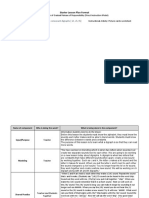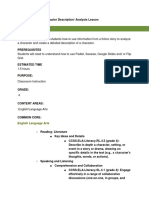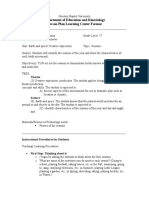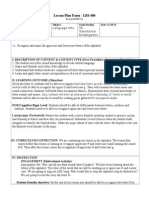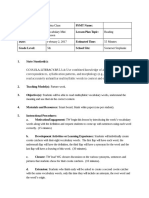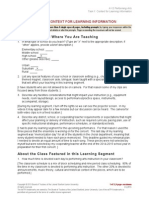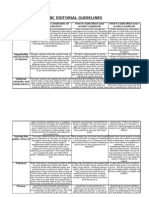Lesson Plan Template: GCU College of Education
Lesson Plan Template: GCU College of Education
Uploaded by
api-532361072Copyright:
Available Formats
Lesson Plan Template: GCU College of Education
Lesson Plan Template: GCU College of Education
Uploaded by
api-532361072Original Title
Copyright
Available Formats
Share this document
Did you find this document useful?
Is this content inappropriate?
Copyright:
Available Formats
Lesson Plan Template: GCU College of Education
Lesson Plan Template: GCU College of Education
Uploaded by
api-532361072Copyright:
Available Formats
GCU College of Education
LESSON PLAN TEMPLATE
Section 1: Lesson Preparation
Teacher Candidate Stevie Higbee
Name:
Grade Level: 9th Grade
Date: 1/26/2020
Unit/Subject: Algebra 1
Instructional Plan Title: Solving Equations
Lesson Summary and This lesson is focused on identifying and solving equations that are found
Focus: in word problems. Students will be sure to understand the vocabulary
used so that they can easily identify them.
Classroom and Student In this class, there is only one student with an actual IEP. Other students
Factors/Grouping: struggle with behavioral tendencies and staying on task. These factors
influence the nature of the lesson to include engaging activities
throughout the lesson. Also, support is given by paraprofessionals and
peers as needed so that students do not fall behind during instruction
and/or activities.
National/State Learning A-CED.A.1: Create equations and inequalities in one variable and use them to
Standards: solve problems. Include equations arising from linear and quadratic functions,
and simple rational and exponential functions.
Specific Learning Given a word problem, students will create an equation to solve for
Target(s)/Objectives: an unknown variable correctly within two attempts, without the use
of notes or textbook.
Academic Language Constant
© 2018. Grand Canyon University. All Rights Reserved.
GCU College of Education
LESSON PLAN TEMPLATE
Coefficient
Expression
Equation
Relationship
Operator
Term
Variable
During the delivery of the lesson, I will have the words on the board and
have the students write down all the terms and definitions in their notes.
Then, during the roam the room activity, they will have the opportunity to
practice their vocabulary skills by completing the Equation Vocabulary
worksheet.
Resources, Materials, Projector
Equipment, and White-Board & Markers
Technology: Algebra tiles
Pencils
Laptops
Equation Vocabulary (Worksheet)
Tina’s Garden (Worksheet)
Section 2: Instructional Planning
Anticipatory Set Time
Needed
As the students enter class, they will find an equation written on the board. On their 15
desk, they will see a written term that is part of the equation. Those with the same term
are in a group (intentionally grouped)
Groups will designate a member to represent their term. And we will work together to
solve the equation on the board by moving the “terms” (aka students) around.
Reviewing solving equations will relate to the lesson because the students will be
identifying equations within word problems and will need to solve them.
© 2018. Grand Canyon University. All Rights Reserved.
GCU College of Education
LESSON PLAN TEMPLATE
Multiple Means of Representation Time
Needed
A PowerPoint presentation will be given to discuss how work problems are 25
approached.
A video will then be shown on a projector how to solve word problems by create linear
equation and finding the solution. https://youtu.be/-EwUcnZx4dI
The roam the room Activity includes the Visual practice, Hands-on Manipulatives,
and a written worksheet to practice vocabulary.
Explain how you will differentiate materials for each of the following groups:
English language learners (ELL):
Students will be able to read the key terms and ideas and hear them spoken by the teacher. These
students will also be able to replay the video at any time for extra help.
Students with special needs:
Writing notes will help concepts become more concrete for students and allow for review later if
necessary. These students will also be able to replay the video at any time for extra help.
Students with gifted abilities:
The students with gifted abilities are given opportunities to help the other students with the
content.
Early finishers (those students who finish early and may need additional
resources/support):
These students are given opportunities to help the other students with the content, or they can
have more practice on Khan Academy.
Multiple Means of Engagement Time
Needed
Your goal for this section is to outline how you will engage students in interacting with the
30
content and academic language. How will students explore, practice, and apply the content? For
example, you may engage students through collaborative group work, Kagan cooperative
learning structures, hands-on activities, structured discussions, reading and writing activities,
experiments, problem solving, etc.
In a bulleted list, describe the activities you will engage students in to allow them to explore,
practice, and apply the content and academic language. Bold any activities you will use in the
lesson. Also, include formative questioning strategies and higher order thinking questions you
might pose.
© 2018. Grand Canyon University. All Rights Reserved.
GCU College of Education
LESSON PLAN TEMPLATE
During the roam the room activity students will approach four different tasks around the
room and complete them. “Regardless of whether the student is the speaker or the
listener, these discussions can lead to a deeper understanding of the material,” (Reiser,
2017, p. 91).
They will be going around the room to complete different activities at each of the four
tables that have them participating in collaborative group work.
Table 1 is the Equation Vocabular Worksheet. Each student will complete their own
worksheet; however, the group is allowed to discuss and work together.
Table 2 is visual practice of solving equations on the board. Paraprofessional will be
monitoring this station to make sure students are completing the equations correctly.
Each person in the group will be taking a turn with the marker in their hand for an
equation.
Table 3 is solving equations by utilizing manipulatives (Algebra Tiles)
Table 4 is working as a group to solve a word problem.
I will be monitoring table 4 by asking Higher order thinking questions such as,
-How do we solve a word problem?
-What terms in a word problem tell you how to set up an equation?
-What are the identities used to solve an algebraic equation?
-How can we check to make sure our solution is correct?
The students will have 2 attempts at the “Tina’s Garden” worksheet. First will be
following the Anticipatory set, then they will receive a second copy at the end of the
lesson to self-evaluate their progress that they made that day. They are able to look at
both to show what they have learned in class that day.
Explain how you will differentiate activities for each of the following groups:
English language learners (ELL):
The groups are selected by design of the teacher to enhance learning for all students.
Students with special needs:
Students with computational struggles will be allowed to use a calculator or a times table
worksheet.
Students with gifted abilities:
Due to the collaborative design of most of the activities, these students will be enhancing their
learning by explaining the content to their peers.
Early finishers (those students who finish early and may need additional
resources/support):
Due to the collaborative design of most of the activities, these students will be enhancing their
learning by explaining the content to their peers.
© 2018. Grand Canyon University. All Rights Reserved.
GCU College of Education
LESSON PLAN TEMPLATE
Multiple Means of Expression Time
Needed
Learners differ in the ways they navigate a learning environment and express what they know.
20
Your goal in this section is to explain the various ways in which your students will demonstrate
what they have learned. Explain how you will provide alternative means for response, selection,
and composition to accommodate all learners. Will you tier any of these products? Will you offer
students choices to demonstrate mastery? This section is essentially differentiated assessment.
In a bulleted list, explain the options you will provide for your students to express their knowledge
about the topic. For example, students may demonstrate their knowledge in more summative
ways through a short answer or multiple-choice test, multimedia presentation, video, speech to
text, website, written sentence, paragraph, essay, poster, portfolio, hands-on project, experiment,
reflection, blog post, or skit. Bold the names of any summative assessments.
Students may also demonstrate their knowledge in ways that are more formative. For example,
students may take part in thumbs up-thumbs middle-thumbs down, a short essay or drawing, an
entrance slip or exit ticket, mini-whiteboard answers, fist to five, electronic quiz games, running
records, four corners, or hand raising. Underline the names of any formative assessments.
For example:
Students will complete a one-paragraph reflection on the in-class simulation they experienced.
They will be expected to write the reflection using complete sentences, proper capitalization and
punctuation, and utilize an example from the simulation to demonstrate their understanding.
Students will also take part in formative assessments throughout the lesson, such as thumbs up-
thumbs middle-thumbs down and pair-share discussions, where you will determine if you need to
re-teach or re-direct learning.
The first attempt of Tina’s Garden worksheet is a pre-test as it will be completed
individually.
The roam the room Activity will allow the teacher to observe and utilize the
higher order thinking questions to formatively assess students’ progress.
The paraprofessional will collaborate with the teacher after class to communicate
their observations.
Their exit ticket is to complete the second attempt at the Tina’s Garden worksheet
and mark where mistakes were made (if any) on the first attempt. This is a great
self-reflection/self-grading strategy which allows teachers to see the process of
the students’ learning (Sanchez, Atkinson, Koenka, Moshontz, & Cooper, 2017).
Explain if you will differentiate assessments for each of the following groups:
English language learners (ELL):
These students will be able to reference their vocabulary worksheet at any time for extra help.
Students with special needs:
The student with the difficulty with calculations will be allowed to utilize a calculator during the
entirety of the individual work.
Students with gifted abilities:
© 2018. Grand Canyon University. All Rights Reserved.
GCU College of Education
LESSON PLAN TEMPLATE
If these students completed the Tina’s Garden worksheet the first time, then they can create
explanations as to why and how the answers are obtained.
Once that’s completed, they can do extra practice on Khan academy and begin on warm ups for
the graphing the equations lesson.
Early finishers (those students who finish early and may need additional
resources/support):
If these students completed the Tina’s Garden worksheet the first time, then they can create
explanations as to why and how the answers are obtained.
Once that’s completed, they can do extra practice on Khan academy and begin on warm ups for
the graphing the equations lesson.
Extension Activity and/or Homework Time
Needed
Extra practice on Khan Academy. Khan academy provides videos and extra practice problems -
for free online. The extra videos may present it in a different way than the teacher provided and
can enhance the understanding of the concepts. Students who understand the topic well are
able to work on more advanced topics. Teachers and parents can login on the website and
monitor student’s progress at home for free and see what they may be struggling on.
Rationale/Reflection
After writing your complete lesson plan, explain three instructional strategies you included in your
lesson and why. How do these strategies promote collaboration, communication, critical thinking,
and creativity? Bold the name of the strategy.
For example:
.
Roam the room promotes engagement, communication, and collaboration because all
students get a chance to share their ideas or answers in their small groups. This is
beneficial to students because they get to put their ideas into words and hear and
discuss the perspectives of others during multiple activities.
During the roam the room activity, some incorporated instructional strategies included
think-aloud and manipulatives.
Self-Reflection during the observation between the first and second attempt of Tina’s
Garden worksheet. This is a great self-reflection/self-grading strategy which allows
teachers to see the process of the students’ learning (Sanchez, Atkinson, Koenka,
Moshontz, & Cooper, 2017).
© 2018. Grand Canyon University. All Rights Reserved.
GCU College of Education
LESSON PLAN TEMPLATE
Equation Vocabulary
In 3x + 7 = 32, In 3x + 7 = 32,
7 is a/an __________. 3 is a/an ____________.
In 3x + 7 = 32, In 3x +7 = 32,
x is a/an ____________. 32 is a/an ____________.
In 3x + 7 = 32, In 3x + 7 = 32,
3x is a/an ____________. 3x + 7 is a/an ____________.
In 12ab – 6z = 99a + 4, In 12ab – 6z = 99a + 4,
list all of the coefficients. list all of the terms.
In 12ab – 6z = 99a + 4, In 12ab – 6z = 99a + 4,
list all of the expressions. list all of the variables.
Name__________________ Date__________
© 2018. Grand Canyon University. All Rights Reserved.
GCU College of Education
LESSON PLAN TEMPLATE
Name:________________________________
Date:_____________
Tina’s Garden
The Perimeter of Tina’s rectangular garden is 60ft. If the length of the garden is
twice the width, then what are the dimensions of the garden?
What key terms tell how to set up the equation?
___________________________________________________________________
___________________________________________________________________
What does the variable represent in this problem?
___________________________________________________________________
___________________________________________________________________
© 2018. Grand Canyon University. All Rights Reserved.
GCU College of Education
LESSON PLAN TEMPLATE
Collaboration with Colleagues Rationale
In order to execute the ideas and plans for this lesson, I would have to communicate and
collaborate with both our special needs teacher and a paraprofessional. Thankfully, I feel very
comfortable and confident in the willingness of the staff at our school. “In order to engage in
collaborative work, teachers must trust their colleagues and be willing to experiment with a
collaborative approach,” (Jao & McDougall, 2016, p. 560). The special needs teacher could
provide me with some further insight on what will work and what to try to enhance the learning
experience for the students who have struggles with behavior, computation, and attention. With a
bit more knowledge from him during the planning process, I will be better equipped with
knowledge to help students who need the extra help. The paraprofessional may also have some
feedback regarding activity ideas to maintain engagement and motivation. “Collaborating
teachers can look to each other to seek out examples of exemplary practice and to reflect on their
own teaching practices,” (Jao & McDougall, 2016, p. 560). It will also be vital to plan a day
where she can dedicate that class period to helping our roam the room activity. By collaborating
with my colleagues it will enhance the educational experience for all of my students. “Of course,
the ultimate benefit of teacher collaboration is that it can improve student achievement,” (Jao &
McDougall, 2016, p. 561).
© 2018. Grand Canyon University. All Rights Reserved.
GCU College of Education
LESSON PLAN TEMPLATE
References
Jao, L., & McDougall, D. (2016). Moving beyond the barriers: supporting meaningful teacher
collaboration to improve secondary school mathematics. Teacher Development, 20(4),
557–573. https://doi-org.lopes.idm.oclc.org/10.1080/13664530.2016.1164747
Reiser, E. (2017). Blending individual and group assessment: A model for measuring student
performance. Journal of the Scholarship of Teaching and Learning, 17(4), 83–94.
Retrieved from https://search-ebscohost-com.lopes.idm.oclc.org/login.aspx?
direct=true&db=eric&AN=EJ1159854&site=eds-live&scope=site
Sanchez, C. E., Atkinson, K. M., Koenka, A. C., Moshontz, H., & Cooper, H. (2017). Self-
grading and peer-grading for formative and summative assessments in 3rd through 12th
grade classrooms: A Meta-Analysis. Journal of Educational Psychology, 109(8), 1049–
1066. Retrieved from https://search-ebscohost-com.lopes.idm.oclc.org/login.aspx?
direct=true&db=eric&AN=EJ1160620&site=eds-live&scope=site
© 2018. Grand Canyon University. All Rights Reserved.
You might also like
- 321 Edtpa Phonics Lesson Plan Week 5Document6 pages321 Edtpa Phonics Lesson Plan Week 5api-436063485No ratings yet
- Cooperative Learning Lesson PlanDocument3 pagesCooperative Learning Lesson Planapi-400613684No ratings yet
- Ell Lesson Plan 1Document5 pagesEll Lesson Plan 1api-282301130100% (1)
- Rhyme Lesson PlanDocument5 pagesRhyme Lesson Planapi-252920831No ratings yet
- Lesson Plan Template For Residency Students 12-3Document5 pagesLesson Plan Template For Residency Students 12-3Tahtiana BrooksNo ratings yet
- Reading Lesson On Inferences-Room OneDocument2 pagesReading Lesson On Inferences-Room Oneapi-249813105100% (1)
- DLL - English 6 - Q2 - W5Document3 pagesDLL - English 6 - Q2 - W5RyanNo ratings yet
- Shakespeare Sonnet Lesson PlanDocument2 pagesShakespeare Sonnet Lesson Planapi-398283556No ratings yet
- Udl Lesson Plan RevisedDocument6 pagesUdl Lesson Plan Revisedapi-285462200No ratings yet
- Intro To Fractions Lesson PlanDocument6 pagesIntro To Fractions Lesson Planapi-312604279100% (1)
- Edtpa Pfa Assessment CommentaryDocument9 pagesEdtpa Pfa Assessment Commentaryapi-302458246No ratings yet
- Phonics A Lesson Plan-BrittanyjohnsonDocument3 pagesPhonics A Lesson Plan-Brittanyjohnsonapi-533709691No ratings yet
- Lesson Plan Rhyming WordsDocument4 pagesLesson Plan Rhyming Wordsapi-271048356100% (2)
- Lesson Plan Ss TimelineDocument6 pagesLesson Plan Ss Timelineapi-354129021No ratings yet
- Reading Small Group LessonDocument4 pagesReading Small Group Lessonapi-407044971No ratings yet
- Bad Case of Stripes Lesson PlanDocument2 pagesBad Case of Stripes Lesson Planapi-158222957No ratings yet
- Reading Onset, Rime LessonDocument4 pagesReading Onset, Rime Lessonkelsey_criswellNo ratings yet
- Interactive Read Aloud The Bad SeedDocument5 pagesInteractive Read Aloud The Bad Seedapi-438529073No ratings yet
- Miscue Report SampleDocument5 pagesMiscue Report SampleStephanie del angelNo ratings yet
- Kahoot Lesson PlanDocument3 pagesKahoot Lesson Planapi-30167328467% (3)
- Lesson Plan GR 3 FractionsDocument5 pagesLesson Plan GR 3 Fractionsapi-267810292No ratings yet
- Comprehension Lesson PlanDocument12 pagesComprehension Lesson Planapi-464778396No ratings yet
- Chap 1Document33 pagesChap 1Mẹdạy Đặttên Đừng Quádài0% (1)
- IGCSE Literature Essay Writing ChecklistDocument1 pageIGCSE Literature Essay Writing ChecklistChyrsella VerenaNo ratings yet
- OUM AssignmentDocument5 pagesOUM AssignmentOctavius GuNo ratings yet
- Coe-Lesson-Plan-Template KG Math PatternsDocument4 pagesCoe-Lesson-Plan-Template KG Math PatternsMaryum NisarNo ratings yet
- Kids at Work Lesson PlanDocument9 pagesKids at Work Lesson Planapi-307745735No ratings yet
- Udl Lesson Plan Assignment MacdonaldDocument11 pagesUdl Lesson Plan Assignment Macdonaldapi-448386725100% (1)
- Lesson Plan First GradeDocument4 pagesLesson Plan First GradeAlexSiDeeaLacatusNo ratings yet
- 4th Grade Lesson Plan On AdjectivesDocument2 pages4th Grade Lesson Plan On Adjectivesapi-272774267No ratings yet
- Spede 774 Writing Lesson PlanDocument4 pagesSpede 774 Writing Lesson Planapi-273589202No ratings yet
- Lesson Plan - Northeast RegionDocument4 pagesLesson Plan - Northeast Regionapi-245996399No ratings yet
- LESSON PLAN Reading Phoneme OeDocument3 pagesLESSON PLAN Reading Phoneme OeMuhammad Saifullah100% (1)
- Integrated Lesson Plan 1 DramaDocument2 pagesIntegrated Lesson Plan 1 Dramaapi-394257560No ratings yet
- PBL Lesson PlanDocument17 pagesPBL Lesson Planapi-646128661No ratings yet
- Lesson Plan TKDocument3 pagesLesson Plan TKapi-296995969No ratings yet
- Fiction Vs Nonfiction Lesson PlanDocument2 pagesFiction Vs Nonfiction Lesson Planapi-636545998100% (1)
- Cause-Effect Lesson Plan ReadDocument12 pagesCause-Effect Lesson Plan Readapi-241278585100% (1)
- 1st Grade ELA Lesson 3Document7 pages1st Grade ELA Lesson 3Jessica KalvaitisNo ratings yet
- Uae FlagDocument2 pagesUae Flagapi-307983330100% (1)
- Drama Lesson Plan KellisDocument8 pagesDrama Lesson Plan Kellisapi-357504839No ratings yet
- 8 Lesson 2 - Peer TeachingDocument5 pages8 Lesson 2 - Peer Teachingapi-384800531No ratings yet
- Sped ObservationDocument6 pagesSped Observationapi-282105125No ratings yet
- 2nd Grade Math Lesson Plan 3-Digits PDFDocument7 pages2nd Grade Math Lesson Plan 3-Digits PDFapi-430893986No ratings yet
- Detailed Lesson Plan in EnglishDocument7 pagesDetailed Lesson Plan in EnglishMonica Faye AlcarazNo ratings yet
- Vocabulary Mini Lesson PDFDocument2 pagesVocabulary Mini Lesson PDFReina ClausNo ratings yet
- The Name Story Lesson 2015Document3 pagesThe Name Story Lesson 2015api-239565419No ratings yet
- Lesson 2Document3 pagesLesson 2api-245823147100% (1)
- UNLV/Department of Teaching & Learning Elementary Lesson Plan TemplateDocument2 pagesUNLV/Department of Teaching & Learning Elementary Lesson Plan Templateapi-403209118No ratings yet
- Lbs400lesson Plan Step3Document4 pagesLbs400lesson Plan Step3api-370979946No ratings yet
- Lesson Plans For Learning SegmentDocument12 pagesLesson Plans For Learning Segmentapi-353068872No ratings yet
- Rhyming With Chicka Chicka Boom Boom: Learning ObjectivesDocument2 pagesRhyming With Chicka Chicka Boom Boom: Learning ObjectivesVince Lamina100% (1)
- Social Studies Lesson PlanDocument3 pagesSocial Studies Lesson Planapi-434045053No ratings yet
- Free Verse Poetry Lesson Plan by Desiree Oliverio and Sasha Rose ReyesDocument3 pagesFree Verse Poetry Lesson Plan by Desiree Oliverio and Sasha Rose Reyesapi-356650705No ratings yet
- 'Oi' Lesson PlanDocument2 pages'Oi' Lesson PlanEuresha Jeremiah100% (1)
- Edtpa Pfa Context For LearningDocument3 pagesEdtpa Pfa Context For Learningapi-302458246No ratings yet
- Grade 7 Expository Writing Rubric-FinalDocument1 pageGrade 7 Expository Writing Rubric-Finalapi-265255892No ratings yet
- Lesson Plan - Body PartsDocument5 pagesLesson Plan - Body Partsapi-355947604No ratings yet
- 6ELA StudySync PlanningandCoachingGuideDocument8 pages6ELA StudySync PlanningandCoachingGuidemariah felixNo ratings yet
- Aralin 1 - Pulso NG MusikaDocument18 pagesAralin 1 - Pulso NG MusikaMean De Castro ArcenasNo ratings yet
- Lesson Plan in Listening SkillsDocument2 pagesLesson Plan in Listening SkillsAre KushiNo ratings yet
- ECE 455coe-Lesson-Plan-TemplateDocument7 pagesECE 455coe-Lesson-Plan-Templatenromero-peraltaNo ratings yet
- GCU Lesson Plan TemplateDocument7 pagesGCU Lesson Plan TemplateKeyania MurrayNo ratings yet
- Clinical Practice 3 Lesson PlanDocument7 pagesClinical Practice 3 Lesson Planapi-708067647No ratings yet
- Classroom Overview-BrochureDocument2 pagesClassroom Overview-Brochureapi-532361072No ratings yet
- Professional Development PlanDocument2 pagesProfessional Development Planapi-532361072No ratings yet
- Cpe 3Document12 pagesCpe 3api-532361072No ratings yet
- Points 87.4: Clinical Practice Evaluation 2SDocument14 pagesPoints 87.4: Clinical Practice Evaluation 2Sapi-532361072No ratings yet
- Resume 09Document2 pagesResume 09api-532361072No ratings yet
- Evaluation 1Document7 pagesEvaluation 1api-532361072No ratings yet
- Step 7Document3 pagesStep 7api-532361072No ratings yet
- Gcu Student Teaching Evaluation of Performance Step Standard 1 Part I - SignedDocument4 pagesGcu Student Teaching Evaluation of Performance Step Standard 1 Part I - Signedapi-532361072No ratings yet
- Gcu Student Teaching Evaluation of Performance Step Standard 1 Part II Part 1 - Signed 1Document5 pagesGcu Student Teaching Evaluation of Performance Step Standard 1 Part II Part 1 - Signed 1api-532361072No ratings yet
- Professional Dispositions Assessment CompleteDocument2 pagesProfessional Dispositions Assessment Completeapi-532361072No ratings yet
- Graduate-Profile SampleDocument1 pageGraduate-Profile SampleLuis Alfonso Buitrago TorresNo ratings yet
- BBC Editorial GuidelinesDocument4 pagesBBC Editorial GuidelinesnikkiNo ratings yet
- Teen Patti Life DM StrategyDocument16 pagesTeen Patti Life DM StrategyBarin DasNo ratings yet
- PRAGMATICSDocument3 pagesPRAGMATICSdanijela_vuković_3No ratings yet
- Lesson 3 Imaging and Design For Online EnvironmentDocument2 pagesLesson 3 Imaging and Design For Online EnvironmentLar KenNo ratings yet
- Official Resume Christopher NeckermannDocument1 pageOfficial Resume Christopher NeckermannChris NeckermannNo ratings yet
- Why A Global LanguageDocument3 pagesWhy A Global LanguageGabriel Dan BărbulețNo ratings yet
- Presentation Skills Checklist: Delivery ContentDocument1 pagePresentation Skills Checklist: Delivery ContentJamesNo ratings yet
- ShivamIsrani - 23 - UI-Lab - Practical 1Document5 pagesShivamIsrani - 23 - UI-Lab - Practical 1Shivam IsraniNo ratings yet
- Fs 2 Learning Episode 10Document10 pagesFs 2 Learning Episode 10Jay LexNo ratings yet
- PPST Resource Package, EditedDocument70 pagesPPST Resource Package, EditedCYIREL R. BARBACENA75% (4)
- KittuDocument3 pagesKittuKunika AgarwalNo ratings yet
- Course: Textbook Development-II (6553) Semester: Autumn, 2022Document13 pagesCourse: Textbook Development-II (6553) Semester: Autumn, 2022Saeed RanaNo ratings yet
- Declamation RubricsDocument1 pageDeclamation RubricsAiken MarceloNo ratings yet
- Ethnologue - Languages of The World - Browse by Language Family - Eberhard, Simons, Fennig 2019 SILDocument1 pageEthnologue - Languages of The World - Browse by Language Family - Eberhard, Simons, Fennig 2019 SILkrenari68No ratings yet
- Activity Guide and Evaluation Rubric - Unit 2 - Task 4 - Rewording IdeasDocument7 pagesActivity Guide and Evaluation Rubric - Unit 2 - Task 4 - Rewording IdeasHeder MartinezNo ratings yet
- EXPO Presentation - Joy Zheng - Joy ZhengDocument24 pagesEXPO Presentation - Joy Zheng - Joy ZhengnurjNo ratings yet
- Mission and VisionDocument2 pagesMission and VisionDeepak MishraNo ratings yet
- Discourse Community Disscussion and Activity TriangleDocument3 pagesDiscourse Community Disscussion and Activity Triangleapi-301806252No ratings yet
- NUTELLA PPT 2Document12 pagesNUTELLA PPT 2yamini kandikattuNo ratings yet
- D058 Zhu Yuan Neo-Mat-BuildingDocument10 pagesD058 Zhu Yuan Neo-Mat-BuildingMariana DantasNo ratings yet
- Final Reflection PaperDocument7 pagesFinal Reflection Paperapi-643305184No ratings yet
- Diass Handout 2Document3 pagesDiass Handout 2Charlene Mae GraciasNo ratings yet
- Class WorkshopDocument3 pagesClass WorkshopSantiago Cifuentes Ramírez100% (1)
- Sertifikat 2Document2 pagesSertifikat 2teshaNo ratings yet
- 60-80s Pop Culture ProjectDocument3 pages60-80s Pop Culture Projectapi-294925785No ratings yet











